Watch: Exploring notation with Bach
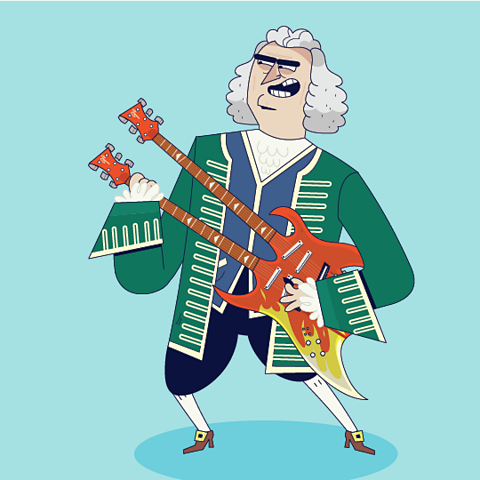
In music, the rhythmA pattern of sounds of different durations. and pitchHow high or low a musical sound is. of notes can be written in different ways such as:
- Western notation
- guitar tabs
- rhythm notation
But music notation can do much more than that.
Watch as Lightning Jelly explore different notation with Johann Sebastian Bach.

Izzy: Whoops! How does this bit go again?
Hasan: How can you forget? It’s easy… Oh hang on, I’ve forgotten it too.
Ed: Er, me too…
Ruby: Yeah, we’re more forgetful than Mr… Umm…
Asha: Maybe we’d remember if f I wrote it down! There’s the quick bit, then the squiggly bit, then the badaboom badabing bit… See?
Ruby: Let’s take five.
Izzy: Woah! A BACH music game!
Ed: YOU’RE really good Ruby!
BACH: STOP IT! Don’t give up on your song! You just need to write it down with some NOTATION. Come with me if you want to not forget!
BACH: LEVEL ONE: RHYTHM
Ed: Oh I get it! The dot is a short note, and the dash is a long one.
BACH: QUICK. Get to the guitar!
BACH: LEVEL TWO: PITCH
Hasan: Woah! The height of the notes show the pitch.
Ruby: Yeah, the low notes down here.
Izzy: And the high notes up here!
BACH: Come on! Faster!
BACH: LEVEL THREE: WESTERN NOTATION.
BACH: This is how I write my music down. The space between the notes shows the duration, and the height shows the pitch. Ha-ha!
Ed: What about guitar tabs?
BACH: Yes! You got it! That is another way of writing music down. Writing music down allows other people to play and helps you forgetful folk remember it. So do it. Come on! Do it now!
Asha: No problemo!
BACH: You guys are gonna make great composers! But I’ll be Bach!
What are the features of musical notation?

There are several important parts of musical notation to consider.
- Notes - these show the pitch and durationThe length of time each note is played for. of the individual note.
- Time signature - this shows the number of beats per barA bar is a way of organising written music. Each bar is a moment of time..
- Key signature - this shows the key note and what sharpsA note played in a higher pitch by a semitone (half step). and flatsA note which is lower in pitch by a semitone. to play.
- Tempo - this shows how fast the music should be played.
- Dynamics - this shows what volume the music should be played at.
What are notes?
Here are some notes you may have already come across.
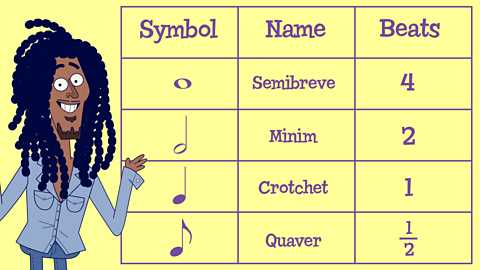
What's a time signature?
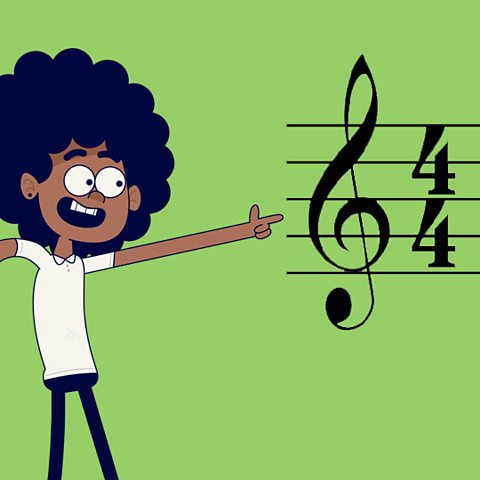
A time signature tells you how many beats are in the bar.
It's written as two numbers at the beginning of every piece of music.
In this example, the top number of the time signature tells us there are four beats in each bar.
This might change to three or four depending on the piece of music.

What's a key signature?
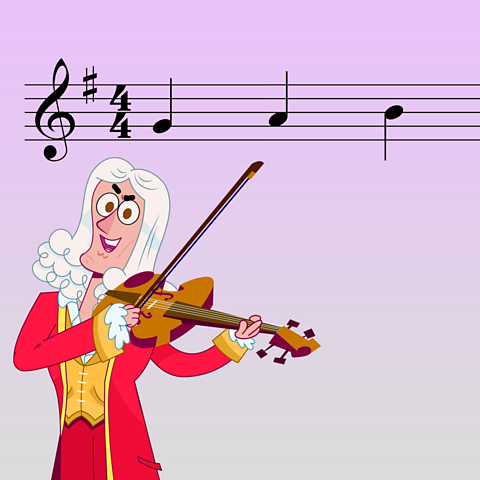
The key signature tells you what the key note is and what sharps or flats are in a piece of music.
It is written as sharps or flats after the clefA symbol used to represent the pitch of notes on musical notation. (and before the time signature) at the beginning of the music.
A piece can be in a major or minor key. This example shows the key is G major as there is an F#.
How is tempo notated?

The tempo of a piece of music is related to its speed.
There are lots of musical terms that are used to describe the speed of a piece of music.
These are normally written above the music. This example shows the piece is to be played allegro (fast) at a tempo of 120bpm (beats per minute).
Many of these words are in Italian because it was mainly Italian composers who invented musical notations we know today.

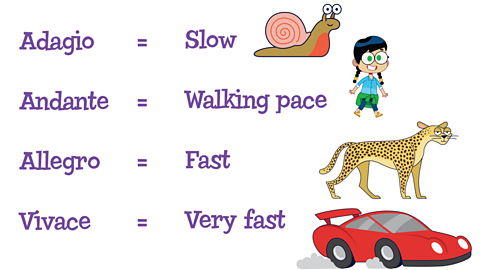
Watch: Tempo challenge
Katie: Clogs tells me we are looking at the speed of music in this next lesson Mr Brown.
Mr Brown: Indeed. And in music we use the word tempo to describe how fast or slow the music is.
Katie: Ah, well, if you like a fast tempo, Mr Brown, just have a listen to Clog's music.
Mr Brown: Clog's makes his own music?
Katie: He does. It's really good. Sometimes when I exercise I like to listen to fast music because it makes me want to move and not stop running.
Mr Brown: I can imagine. I like to listen to slow, calm music when I get home from school because it helps me chill out.
Katie: Yeah. I'd like to do that too, before bed.
Mr Brown: Let's warm up with a listening game.
Katie: Okay. I'm all ears.
Mr Brown: When we hear fast music we have to run on the spot like that. And when we hear slow music we have to run in slowmotion. And we've got until the end of the buzzer sounds.
Katie: OK. I am ready. Let's do this.
[Music plays]
Katie: Phew.
Mr Brown: Great listening Katie.
Katie: Thanks. Are there Italian words we can use to describe the tempo of a piece of music to like we did with dynamics?
Mr Brown: Absolutely. Adagio mean slow just like this.
[Music plays]
Katie: Oh that was spine chilling.
Mr Brown: Now the slow, steady notes in the music had that effect on me as well. In contrast allegro means fast just like this.
[Music plays]
Katie: Ah. Allegro indeed.
Mr Brown: Aha the way you were tapping along to the music is actually a great way to find the pulse in the music.
Katie: The pulse?
Mr Brown: Yes, the pulse of the music is the steady beat that you can tap along to, like the ticking of a clock.
Katie: Why is this helpful?
Mr Brown: Tapping along to the pulse of the music tells us how fast or slow the tempo is.
Katie: I see.
Mr Brown: Let's listen to those two tracks again. But this time I'd like you to copy my tapping actions in time with the beat of the music.
Katie: Ok. Let's do this.
Mr Brown: First off, the adagio tempo.
[Music plays]
Katie: How was that?
Mr Brown: That was perfect. Katie. Now it's going to get a bit trickier with the allegro tempo. Let's go.
[Music plays]
Katie: Well, thank you for all this talk on tempo, Mr Brown.
Watch: How are dynamics notated?
Finally, dynamics in music relate to the volume of the music, or the volume of specific instruments playing a piece.
Like the tempo, these instructions are often in Italian.
In this video, Katie and Mr Brown learn about how two contrasting dynamics - forte and piano can change the way that a piece of music conveys its emotion.
Mr Brown: We're going to kick start our lessons by learning about a very important element of music - dynamics.
Katie: Yes Clogs used this word before. I'm still not totally sure what it means though .
Mr Brown: We use Italian words to describe dynamics. See if you can work out what the words mean, from the way I say them. Now repeat after me. Forte.
Katie: Forte Does it mean one more than thirty nine?
You said it quite loudly so does it mean loud?
Mrs Brown: Bravo, forte is the word. We use for loud sounds and the music, simple for forte. Looks like this.Now, repeat after me piano.
Katie: Piano.Well I love the piano Mr Brown but why are we whispering it?
Mr Brown: No, Katie, I'm not same piano as in the musical instrument. I'm saying piano, which is a word we use for quiet sounds the music symbol for piano. Looks like this.
Dynamics refer to the volume of the music. However, rather than, say, loud or quiet in music. We use Italian words.
Katie: Excellentay! But do you have an example where it's used in music?
Mr Brown: I do, have a listen to this. Here's some forte in action.
[Music plays]
Katie: Wow. That was really powerful.
Mr Brown: It certainly was. You can really hear the dynamic forte, being used by the orchestra here and it makes it really dramatic.Here's an excerpt of music that demonstrates piano perfectly.
[Music plays]
Katie: Oh, yeah. It sounds like someone's like tiptoeing around really quietly, doesn't it?
Mr Brown: I see what you mean there. Now as you've noticed dynamics are important because they make music more dramatic and help the listener feel different emotions.
Katie: Yeah. Dynamics can really bring the music to life.
Mr Brown: Absolutely. If the music is about a celebration, for example, you may expect loud dynamics to create lots of excitement and a party atmosphere. But if the music is about a scary monster sneaking up on someone. It might be very quiet at the start and get louder and louder until the monster appears.
Katie: Aha. So that means we can use both forte and piano in a piece of music?
Mr Brown: That's right. Dynamics can change a lot in one piece of music. Listen to how this composer changes the dynamics from piano to forte in this piece.
[Music plays]
Katie: Oh, I feel so energised after listening to that Mr Brown.
Mr Brown: You're right. Just by changing the dynamics it can make us feel different emotions. We can use musical instruments to explore various dynamics. I've got a mini challenge to show you.
Katie: Oh, you know I love a good challenge.
Mr Brown: I'm going to play this pair of claves using different dynamics and you need to tell me if I'm playing forte or piano.
Katie: Got it.
Mr Brown: Aye, Ok.
[Claves]
Katie: I think that is piano.
Mr Brown: Brilliant. Ok.
[Claves]
Katie: That's forte.
Mr Brown: Well guessed.
[Claves]
Katie: Oh. That was a bit of a tricky one. You did a little bit of piano and then you did some forte.
Mr Brown: Brilliant. Well done, Katie.
Katie: Oh, brilliant. Thank you so much Mr Brown. That was a lot of fun.

Activities
Quiz
Bitesize Primary games. gameBitesize Primary games
Play fun and educational primary games in science, maths, English, history, geography, art, computing and modern languages.

More on Sounds and Symbols
Find out more by working through a topic
- count2 of 4
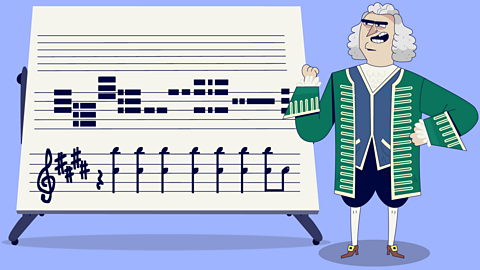
- count3 of 4

- count4 of 4
